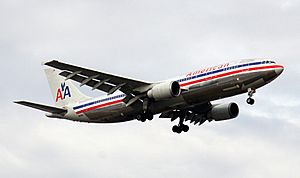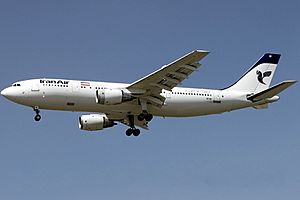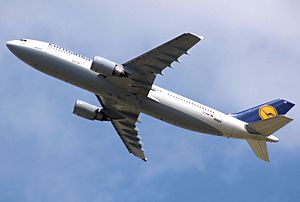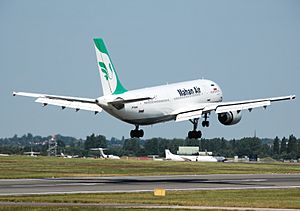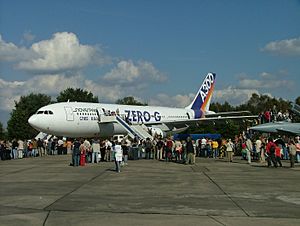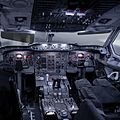Airbus A300 facts for kids
Quick facts for kids A300 |
|
|---|---|
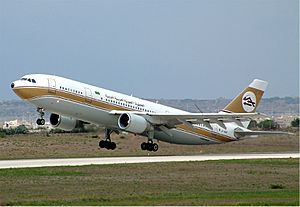 |
|
| Libyan Arab Airlines A300B4-600R taking-off from Malta International Airport in 2002 | |
| Role | Wide-body jet airliner |
| National origin | Multi-national |
| Manufacturer | Airbus |
| First flight | 28 October 1972 |
| Introduction | 30 May 1974 with Air France |
| Status | Out of production, in service |
| Primary users | FedEx Express UPS Airlines European Air Transport Mahan Air |
| Produced | 1974–2007 |
| Number built | 561 |
| Variants | Airbus A310 |
| Developed into | Airbus A330 Airbus A340 |
The Airbus A300 is a large jet airliner made by a company called Airbus. It was a very important plane because it was the first "wide-body" aircraft with only two engines. A wide-body plane has more than one aisle between the seats.
Airbus started making the A300 in 1972. It can carry about 266 passengers. The A300 can fly up to 4,070 nautical miles (7,540 km) when it's full. This distance can change depending on the exact type of A300.
Air France was the first airline to use the A300. They started flying it on May 30, 1974. Airbus stopped making A300s in July 2007. The cargo (freighter) version of the A300 was later replaced by a newer plane, the A330-200F.
Contents
How the A300 Was Made
In 1966, an airline called American Airlines wanted a new plane. They needed a plane with two engines that could hold 250 to 300 passengers. At that time, many American planes had three engines. This was because the FAA had rules that stopped two-engine planes from flying on some long routes.
In September 1967, the governments of Britain, France, and Germany decided to work together. They agreed to design a new plane called the Airbus A300. It was planned to have 300 seats.
Later, the French and British companies involved thought of a different plan. They designed a smaller plane with 250 seats, called the A250. This plane was later named the A300B. It was cheaper to build because it didn't need a brand new type of engine. To help sell the plane in the U.S., they decided to use American General Electric engines instead of British ones. The British government was not happy and stopped supporting the project. However, the British company Hawker Siddeley still helped by designing the wings for the A300.
The A300 flew for the first time in 1972. The first type, the A300B2, started being used by airlines in 1974. The A300B4 followed a year later. At first, Airbus didn't sell many planes. But by 1979, 81 A300s were flying. It was actually the A320 that later helped Airbus become a very big company.
Different parts of the A300 were made by many companies across Europe. These parts were flown to Toulouse-Blagnac in special Aero Spacelines Super Guppy aircraft. There, all the parts were put together to build the plane. This way of building planes turned out to be very good.
Design Features
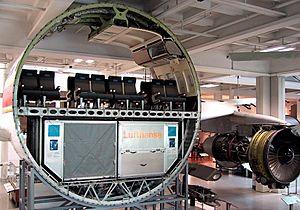
Some of the technology in the Airbus A300 came from the Concorde supersonic jet. When it first started flying in 1974, the A300 was a very modern plane. Some of its cool features included:
- Advanced wings designed by de Havilland.
- Parts made from strong metal pieces called billets, which made the plane lighter.
- Special systems to protect against sudden changes in wind, called wind shear.
- Autopilots that could fly the plane from the moment it took off until it landed.
Newer A300 planes had even more features, such as:
- A glass cockpit, which means the pilots see information on computer screens instead of old-fashioned dials.
- The ability to move fuel around inside the plane. This helps balance the plane's centre of gravity during flight.
- Small upward-pointing parts on the wingtips called Wingtip fences. These were first used on the A310-300.
History of Sales

The A300 didn't sell very well at first. Most of the early orders were from airlines in the countries that helped build Airbus. These included airlines like Air France and Lufthansa.
In 1974, Korean Air ordered four A300s. This was a big deal because they were the first airline outside of Europe to buy an Airbus plane. Airbus believed that South-East Asia was an important place to sell planes. They saw Korean Air as the key to selling more planes in that area.
Airlines that used the A300 for shorter flights faced a problem. They had to fly less often to make sure the planes were full. This meant they lost customers to other airlines that used smaller planes and had more frequent flights. Because of this, Airbus later had to create the A320 to compete with planes like the Boeing 737 and McDonnell Douglas DC-9.
In 1977, Eastern Air Lines rented four A300s. Frank Borman, the boss of Eastern, was very happy. He found that the A300 used much less fuel than his airline's other planes. He then ordered 23 more A300s! After this, Pan Am also ordered some. From then on, many A300s were sold, with a total of 561 planes delivered to airlines.
The basic design of the A300 was used to create other planes. It was made longer for the A330 and A340. It was made shorter for the A310. It was also changed a lot to create the very unique A300-600ST Beluga Super Transporter, which carries large aircraft parts.
In March 2006, Airbus announced they would stop making the A300 and A310. The very last A300 flew for the first time on April 18, 2007. It was given to FedEx on July 12, 2007.
Different Types of Airbus A300
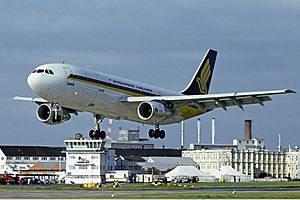
A300B1
Only two of these planes were ever built. One was the very first test plane, called a prototype. The other was a second aircraft. This type could hold 300 to 323 passengers. It used two General Electric CF6-50A engines.
A300B2
This was the first version of the A300 that airlines actually used. It could have either General Electric CF6 or Pratt & Whitney JT9D engines. Air France was the first airline to use it in May 1974.
A300B4
This was the most common version of the A300 built. The first A300B4 flew on December 25, 1974. Germanair was the first airline to get one on May 23, 1975.
A300-600
The official name for this type is the A300B4-600. It has stronger CF6-80 or Pratt & Whitney PW4000 engines. It also has a special small engine called an auxiliary power unit (APU) from Honeywell. The A300-600 started being used in 1983 by Saudi Arabian Airlines. This version also had a more modern cockpit, similar to the A310. This meant it only needed two pilots, and a third crew member called a flight engineer was no longer needed.
A300B10 (A310)
This type is a shorter version of the A300. Like the A300-600, it also doesn't need a flight engineer. The A310 can also be used as a military plane. The Canadian Forces and German Air Force use it today. Airbus sold 260 of these planes.
Accidents
As of 2010, the A300 has been in 54 accidents. In 26 of these, the plane was completely destroyed or damaged beyond repair. This is called a "hull-loss" accident. Sadly, 1,434 people have died in A300 accidents.
Aircraft Still Flying
As of July 2020, more than 200 Airbus A300 planes are still flying around the world.
Details
| Measurement | A300B4 | A300-600R | A300-600F |
|---|---|---|---|
| Length | 53.62 metres (175.9 ft) | 54.08 metres (177.4 ft) | |
| Wingspan | 44.84 metres (147.1 ft) | 44.85 metres (147.1 ft) (with wing fences) | |
| Height | 16.62 metres (54.5 ft) | ||
| Width | 5.28 metres (17.3 ft) | ||
| Cruising speed | mach 0.78 (833 km/h, 518 mph, 450 knots at 35,000 ft) | ||
| Maximum speed | mach 0.86 | mach 0.82 (876 km/h, 544 mph, 473 knots at 35,000 ft) | |
| Engines | CF6-50C2 or JT9D-59A | CF6-80C2 or PW4158 | |
| Cockpit crew | Three | Two | |
Related pages
- Aircraft related to this one
- Similar aircraft
Images for kids
-
Technical director Roger Béteille discussing with general manager Henri Ziegler beside the CF6 turbofan engine, which powered the A300's first flight.
-
Air France started using the A300 on May 23, 1974.
-
Korean Air was the first customer outside Europe to buy the A300 in September 1974.
-
Eastern Air Lines brought the A300 to the U.S. market in 1977.
-
On July 12, 2007, the last A300, a freighter, was delivered to FedEx Express. As of May 2022, FedEx is the biggest operator with 65 A300s still flying.
-
With small wingtip fences, the A300-600 started service in June 1984 with Saudi Arabian Airlines.
-
The longer-range Airbus A310, which is 7 m (23 ft) shorter, was introduced by Swissair in April 1983.
-
The Airbus Beluga is based on the A300, but it has a huge cargo area on top to carry large parts.
See also
 In Spanish: Airbus A300 para niños
In Spanish: Airbus A300 para niños


